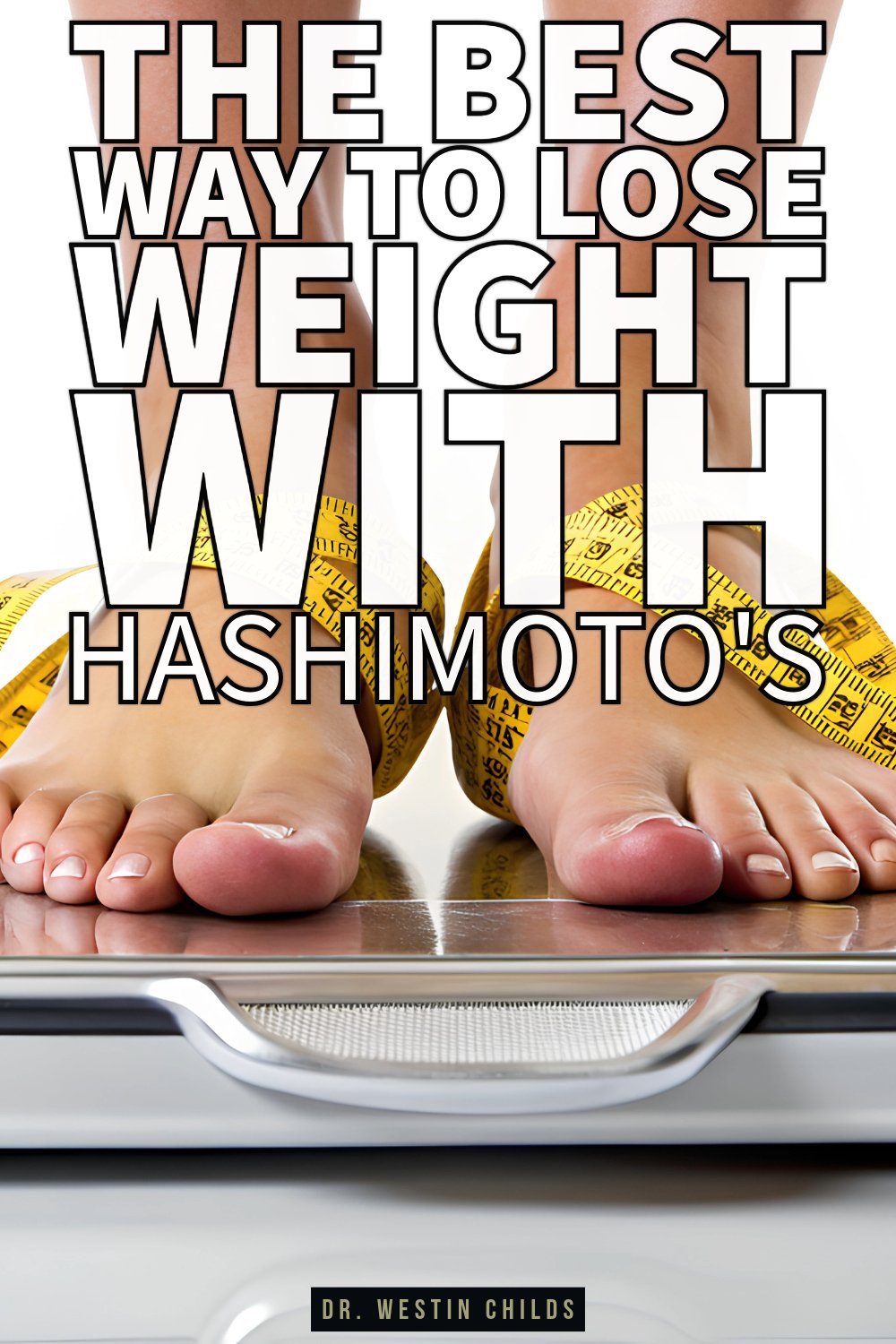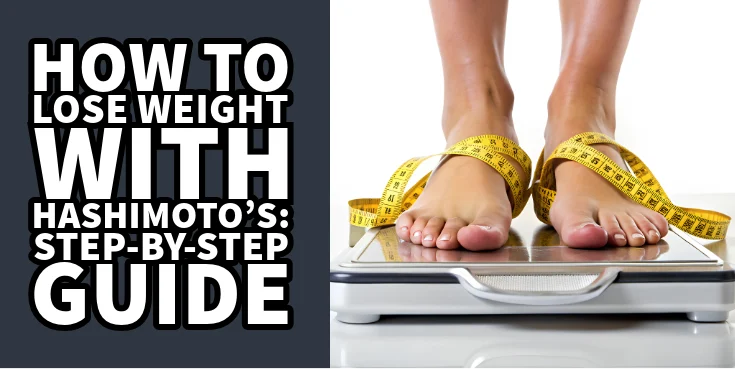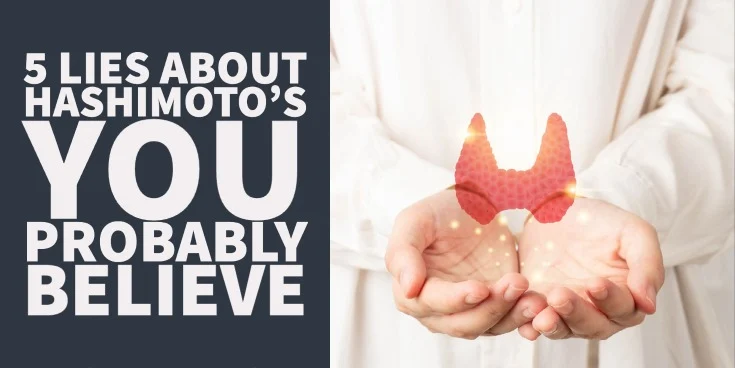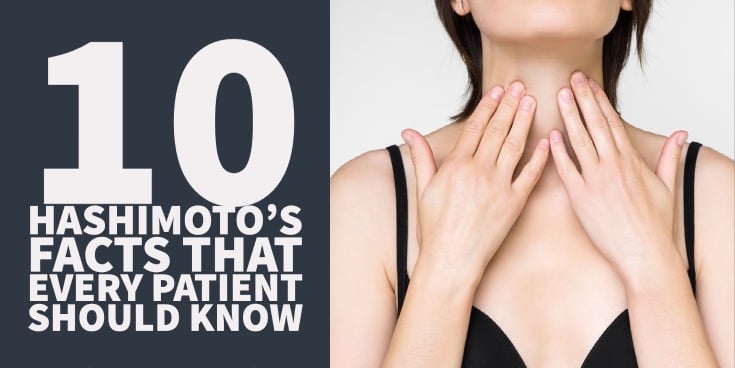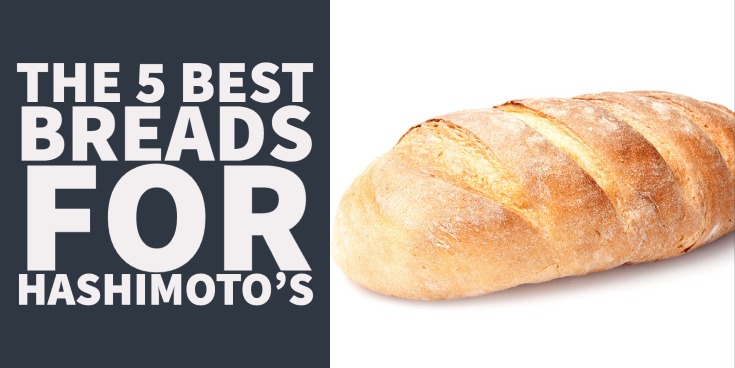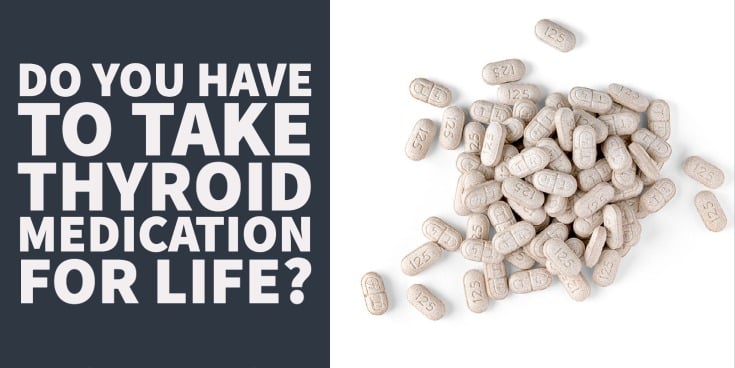Do you have Hashimoto’s and feel like it’s impossible to lose weight?
You’re not alone:
Many patients with Hashimoto’s struggle with the same problem! In fact, it’s one of the biggest complaints among thyroid patients with this autoimmune disease.
The truth is that even though losing weight with Hashimoto’s can be incredibly difficult, it’s far from impossible.
You just need to have the right information so that you can start taking action today.
Today, we are going to be discussing this very topic.
I’m going to teach you how to lose weight if you have Hashimoto’s and provide you with actionable advice and information that has been used by hundreds, if not thousands, of thyroid patients.
No tricks, no gimmicks, just helpful information designed to get you the results you are looking for.
DOWNLOAD FREE RESOURCES
Foods to Avoid if you Have Thyroid Problems:
I’ve found that these 10 foods cause the most problems for thyroid patients. Learn which foods you should avoid if you have thyroid disease of any type.
The Complete List of Thyroid Lab tests:
The list includes optimal ranges, normal ranges, and the complete list of tests you need to diagnose and manage thyroid disease correctly!
Step #1. Start By Checking Your Metabolism
Having a normal metabolism is absolutely critical for weight loss.
Unfortunately for Hashimoto’s patients, the thyroid is one of the major hormones involved in setting and regulating your metabolism.
If there is a problem with your thyroid hormone levels then there will be a problem with your metabolism.
Low thyroid hormone = low metabolism.
How do you check your resting metabolic rate?
There is actually a very simple and cost-effective way to get a decent idea of what your resting metabolic rate is…
That’s by checking your basal body temperature FIRST thing in the morning.
Here’s how you do it:
Put a thermometer and a piece of pen and paper by your bed while you’re sleeping. As SOON as you wake up, check your body temperature (either by mouth or using your underarms) and write down your body temperature each morning.
Repeat this process for at least 7 days (you will need to do it more if you are an ovulating woman).
If your metabolism is contributing to your weight loss resistance then your numbers may look something like this…
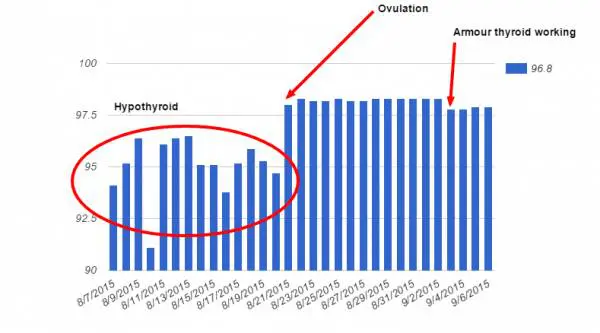
This is a set of basal body temperatures from one of my patients who took her body temperature every day over the course of a month.
The graph easily depicts the chaotic nature of body temperatures that are common when your body doesn’t have enough tissue levels of thyroid hormone.
In her case, you can clearly see the numbers not only increase but become less chaotic during ovulation and after her menstrual cycle after 1 month of treatment with Armour Thyroid.
What else causes chaotic basal body temperatures?
Like many tests in medicine checking your basal body temperature is not a perfect test.
Body temperatures can be off for a number of reasons, but it is a very cheap and cost-effective way of estimating your basal metabolic rate.
There are other conditions that alter your body temperature:
- Adrenal fatigue/problems – Adrenal issues are common in Hashimoto patients and can also result in decreased basal body temperature. If you feel your thyroid dose is optimized then look to your adrenals.
- Ovulation (in a woman) – The ovulatory process causes about a 1-degree increase in body temperature which stays elevated for about 10 days. Checking your basal body temperature is a great way to help determine if you are having anovulatory cycles (which many women with Hashimoto’s experience).

What can you do to treat a slow metabolism?
Most of the time in Hashimoto’s patients (or any patient with Hypothyroidism) a slow metabolism is due to undertreatment of thyroid hormone or using the wrong type of thyroid hormone medication (we will elaborate on how to get on the right dosing and type of medication below).
While proper medication may be the most important factor there are still a number of recommendations you can start implementing today to improve your metabolism…
Consider the following tips:
- Check and treat your adrenal function – Advanced cortisol tests such as salivary cortisol are not always necessary.
- Avoid calorie-restricted diets!
- Make sure you are on the right type and dosing of thyroid hormone – Elaboration below.
- Reduce and avoid (if possible) medications that slow metabolism – I realize this may not be possible for everyone but many medications can slow metabolism: anti-depressants, narcotics, anti-seizure medications, blood pressure medications, steroids, and diabetic medications that cause an increase in insulin levels.
- Get 7-8.5 hours of quality sleep every night.
- Incorporate weight training into your exercise routine to build muscle mass.
Step #2. Get on the Right Type and Dose of Thyroid Hormone Replacement
A huge problem with patients that I see in my practice is that they aren’t on optimal medication or dosing of medication.
This happens frequently because many Doctors will treat only your lab numbers instead of a combination of your symptoms and lab values…
The truth is that your pituitary gland (the organ that secretes TSH) is exquisitely sensitive to thyroid hormones (T4 and T3) because it has different deiodinases than every other cell in the body.

What that means is that your pituitary will be getting enough thyroid hormone (thus lowering your TSH) while many other cells in your body are still starving for thyroid hormone – resulting in symptoms despite a normal TSH.
This results in doctors assuming every cell in your body has enough thyroid hormone when instead really only the pituitary does.
Getting on the Right Type of Thyroid Medication
We need to talk about some basics:
There are two forms of thyroid hormone floating around in your body…
T4 or thyroxine – This is the carrier form of thyroid hormone.
T3 or triiodothyronine – This is the active form of thyroid hormone and the majority in your body comes from T4 conversion to T3 via the various deiodinases.
Most doctors give out T4-only medication and make the assumption that the body will have no problem converting the T4 into the active thyroid hormone T3.
Unfortunately, that rarely seems to be the case nowadays because this process of conversion is inhibited by a number of things: stress, insulin resistance, leptin resistance, prescription medications, and chemical toxins (just to name a few).
For this reason, many patients seem to do better on some form of T3 (triiodothyronine) included in their medication.
Thyroid medication options:
- T4-only medications include: Synthroid, levothyroxine, Tirosint.
- T3-only medications include: Cytomel (liothyronine) or sustained-release T3 (only available from compounding pharmacies).
- Combinations of T3 and T4 medications include: Natural Desiccated Thyroid – Armour Thyroid, WP thyroid, Nature-throid, NP Thyroid, etc., and combinations of T4 & T3 medications (such as the combination of Cytomel + Synthroid or liothyronine + levothyroxine).
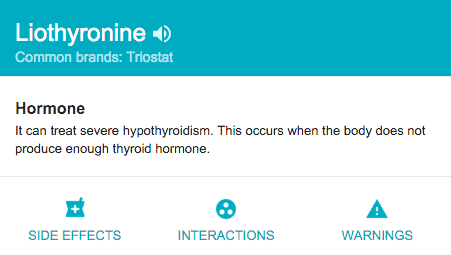
If these medications are all new to you then spend some time reading through the links above to get a better idea of how these various thyroid medications work and how they compare to the typical levothyroxine that most thyroid patients are prescribed.
If you are on a T4-only medication like Synthroid or levothyroxine and you are still symptomatic, then you are likely to benefit from adding T3 to your regimen in some form.
Many thyroid patients opt to take Natural Desiccated Thyroid (NDT) to get both T4 and T3 thyroid hormones, but some people do require higher amounts of T3-only medication and benefit from taking Cytomel alone or in combination with levothyroxine or Synthroid.
Remember that the type of thyroid medication and the dose you need is highly individualized. Don’t make the assumption that if a certain medication worked for someone you know that it will work for you.
The best way to find your type of medication and dose is through trial and error.
Step #3. Eat The Right Foods
I’ve talked extensively about finding the right diet if you have Hashimoto’s here but I will summarize some of the most important points in this article as well.
Diet is absolutely critical to weight loss, reducing the inflammation and autoimmunity associated with Hashimoto’s disease (7), and for your overall health.

Everyone knows this and I probably don’t have to spend any time convincing you that this is the case.
Despite this fact, thyroid patients still seem to experience a lot of confusion when it comes to their diet.
I get questions about diet on my blog, youtube videos, Facebook posts, and instagram posts all of the time.
To dispel some of this confusion, let’s talk about some general guidelines that you should be thinking about when it comes to your diet:
- Diet is highly individualized – what works for you may not work for everyone else.
- Most points (the vast majority) do better when avoiding gluten, dairy, and soy products – I’ve seen some patients who couldn’t lose weight suddenly start shedding points when they remove these food groups.
- Don’t count calories! – Instead focus on nutrient-dense, high-quality, real whole food.
- Avoid excessive sugary carbohydrates – Try to maintain around 20-30% of your total calories from carbohydrates (this varies based on certain hormone imbalances).
- Avoid calorie-restricted diets – or very low-calorie diets at all costs as these do not lead to long-term weight loss.
- Tailor your diet to your specific medical conditions– Many patients with Hashimoto’s suffer from blood sugar dysregulation, adrenal fatigue, and GI imbalances. Each of these problems should be taken into account when searching for your ideal diet.
- Avoid excessive goitrogens – But only if you are sensitive to them. Most people can tolerate healthy foods with minor amounts of goitrogens without any issues. Read this article for more information.

- Quick tip: If you don’t know where to start with your diet, I would start by eliminating wheat (including gluten), dairy, and soy. You may ultimately need a more restrictive diet but 60-80% of patients with Hashimoto’s will see huge improvements with change this alone.
Step #4. Exercise
I know, I know…
You’re not getting the whole “eat less and exercise more” spiel from me, but we can’t talk about weight loss without mentioning exercise.
The problem with Hashimoto’s patients is that they have to be VERY smart about how much to exercise and what types of exercises they do due to how the thyroid impacts energy levels and fatigue.
Figuring out how to navigate fatigue to allow for exercise can be tricky but it isn’t impossible.
Are any of these scenarios familiar?
- You’re told to exercise but you are so fatigued you can barely get out of bed.
- You want to exercise but after exercising you feel like you’ve hit the wall.
- You’re exercising 5 times per week but no matter what you do you can’t lose weight.
These are all too common in Hashimoto’s patients and they are all signs of a deeper problem.

Let me be clear:
You should be exercising, but if your thyroid medication isn’t optimized or you have Adrenal problems you may be doing more harm than good with excessive exercise.
If you fall into one of the scenarios above I would recommend further evaluation of your adrenal function. You would also benefit from checking your basal body temperature.
If the above tests show any issues, then address those problems FIRST before you start exercising again!
While you are fixing those problems make sure you stay active by simply walking for at least 30-60 minutes per day.
Low-intensity exercise like walking is a lot more effective than people realize and can pretty much always be done regardless of how much fatigue you are suffering from.
Start High-Intensity Interval Training
If you feel like your energy level is good enough to incorporate exercise then you may be asking what is the best type of exercise?
For weight loss, the answer is simple: high-intensity interval training or strength training.
These exercises have been shown to be very effective in burning fat and sensitizing your body to insulin (8).
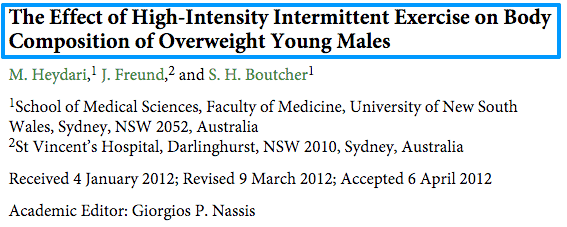
In many people, high-intensity interval training is more effective and requires less time than “cardio” exercises like jogging on a treadmill for 45 minutes every day.

What’s more…
You only have to exercise for 10-20 minutes 3-5x per week to get this benefit.
High-intensity interval training (sometimes referred to as burst training) is a form of exercise where you perform short bursts of all-out maximum effort exercises (9) for about 30 seconds with periods of rest in between.
HIIT can also be done with circuit weight training, on an elliptical, or while jogging/sprinting.
Strength training is also a very effective exercise method for weight loss because it promotes the growth of lean muscle mass, provides you with a constant calorie burn, and can help you age more gracefully.
When deciding which one is best for you, just go with whichever one you are more likely to stay consistent with long-term.
It doesn’t make sense to exercise like crazy for a few weeks only to burn out and not exercise again for another 6 months.
Find something that works for you so that you can consistently work out indefinitely.
This is how you will see the results you are looking for.
- Quick Tip: Ditch the treadmill and start doing HIIT. You will save time, burn more belly fat, sensitize your body to insulin and reverse leptin resistance. But don’t overdo it! Start with 1-2x per week and see how your body tolerates it before adding more days.
Step #5. Make Sure Your Gut Health Is In Order
It seems we can’t have a conversation without including gut health in the mix!
The reason is simple: the 100 trillion little bugs in your gut (known collectively as the microbiome) have a HUGE impact on your health.
These little bugs can increase metabolism, change how you digest food, alter inflammation, release chemicals that speak to your brain and even drive behavior (11)!
Most importantly, for our discussion, is that your gut health can impact your ability to lose weight.
Yes, it’s true:

It’s now clear that certain species of bacteria that live in your gut will either help you lose weight, or help you pack on the pounds.
Akkermansia (12) (part of the ancestral core microbiota) and bacteroidetes (13) seem to be associated with being lean and thin. Whereas higher amounts of Firmicutes are seen in higher amounts in people who have larger waistlines.
The moral of the story?
You need to make sure your gut health is up to par if you want to lose weight.
That means if you are suffering from bloating, alternating constipation, diarrhea, upper abdominal pain, acid reflux/GERD, IBS, IBD, SIBO, leaky gut, yeast overgrowth, or any other gut-related problems you HAVE to get your gut fixed if you want to lose weight!
Unfortunately, Hashimoto’s patients are incredibly susceptible to gut problems because thyroid hormone controls the movement of your bowels and it controls how much stomach acid you put out.
If either of these slows down or is not working properly then you are a perfect setup for gut dysfunction.
Step #6. Reduce Inflammation in Your Body
Many diseases, including the inability to lose weight (14), have roots in chronic low-grade inflammation.
The kind of inflammation that is caused by…
- Chronic Daily Stress (Work, Family, Social, etc.)
- Lack of Sleep (less than 7 hours per night)
- Poor Diet (Standard American Diet)
- Untreated Gut imbalances (SIBO, IBS, IBD, Reflux, Yeast overgrowth, etc.)
- Disturbances in the Gut Microbiome (Dysbiosis)
- Visceral Abdominal Fat (belly and organ fat)

If you want to lose weight you HAVE to address the causes of low-grade chronic inflammation.
Fixing the problem is usually pretty easy once you have figured out what your problem areas are.
In most cases, I recommend starting with the basics. By doing the following things you would be able to reduce the inflammation in your body significantly:
- Focus on relaxing and managing your stress. 20 minutes per day of yoga, meditation, or spiritual prayer should do the trick.
- Focus on getting at least 8 hours of sleep per night. You may need to supplement with relaxing herbs, botanicals, or even hormones like melatonin (though be very cautious when using melatonin).
- Eat nutrient-dense, real whole foods. If your food has a label or more than three ingredients don’t eat it! When in doubt leave it out.
- Fix your gut using some of my recommendations above.
- Take a probiotic and replace nutrient deficiencies (most common being Vitamin B12, fish oil, magnesium, and zinc.
- Exercise (1-2x sessions of HIIT per week) and stay active on days you don’t exercise by walking at least 10,000 steps.
- Quick Tip: Using the strategies above you should be able to completely eliminate inflammation from your body within 1 month. But please note that some people may require further blood testing to get to the root cause of their problem.
Step #7. Pay Attention To Your Cortisol & Adrenal Health
Cortisol is another huge player in weight gain and obesity.
Cortisol works in tandem with insulin and they both tell your body to take whatever calories you’ve consumed and turn them straight into belly fat.
The problem is this:
We as humans were never designed to battle the continuous and constant stress that we put on our bodies on a daily basis.
Our Adrenal glands were meant to provide us excess energy when we need it most, like bursting away from a lion or another form of danger.
Our bodies don’t know how to deal with the constant stress from working 12-hour days, dealing with social distractions, eating poor quality manufactured food, or the sedentary lifestyle of working from a desk 8 or more hours each day.
Our little adrenal glands can only keep up for so long. When they decide to poop out you get what is known as adrenal fatigue (though it’s also known by many other names).

There’s some debate as to whether or not adrenal fatigue actually exists.
I’m going to table that discussion for this article and just say that there is absolutely some condition or syndrome that impacts cortisol in patients with Hashimoto’s.
Whether you want to call that adrenal fatigue or not is up to you, but you can’t ignore the fact that the thyroid is connected to adrenal and cortisol health.
Adrenal Fatigue and Hashimoto’s
Unfortunately, people with Hashimoto’s have another reason to develop adrenal fatigue.
Thyroid hormone works in tandem with adrenal hormones (epinephrine and norepinephrine) to provide your body with energy in the form of ATP, and to maintain your basal metabolic rate.
When your thyroid hormone is low, your adrenals have to work overtime (15) to make up for the difference leading to debilitating and crushing fatigue.

How do you know if you have adrenal fatigue? You may experience any combination of the following symptoms:
- Crushing and debilitating fatigue even after 8 hours of sleep
- Salt and Sugar cravings
- Weight gain, especially in your abdomen
- Racing thoughts or feelings of anxiety, especially at night
- Increased energy in the evening
- Reliance upon caffeine or sugar for energy
- Problems maintaining blood sugar or the sensation of feeling dizzy at times
- Low blood pressure or unstable blood pressure when standing
- Brain fog or sluggish brain function
- Low sex drive
- You can read more about the symptoms of adrenal fatigue here…
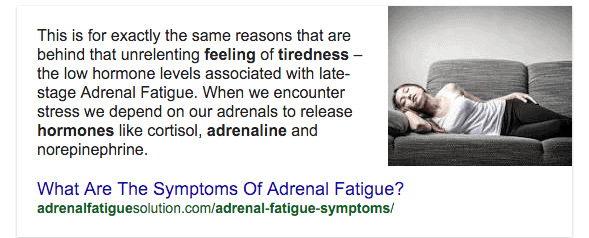
If you find yourself with the symptoms listed above or if you’ve been evaluated and treated for your Hashimoto’s/hypothyroidism but still aren’t 100% then you may be suffering from adrenal fatigue.
The treatment of adrenal fatigue deserves its own blog post but I can give you some quick recommendations to get started right away…
- Avoid Caffeine at all costs – it may be providing you with energy but at the cost of burning out your adrenals.
- Increase your consumption of salt (preferably Celtic sea salt or Himalayan pink salt). I even recommend putting 1 tsp in a large glass of water each morning.
- Consider taking adaptogens such as Rhodiola, ashwagandha, Siberian ginseng, or holy basil. I find that supplements containing ashwagandha or Rhodiola are often best for those with Hashimoto’s due to how they increase thyroid function and directly help with weight loss (but your mileage may vary). I’ve found the best success with this supplement over the years.
- Consider taking adrenal glandulars. Adrenal adaptogens directly help improve energy levels by providing adrenal hormone precursors, enzymes, and other nutrients.
- Take 2 grams of Vitamin C daily to help nourish adrenal function.
- Consume several meals throughout the day, you may need to eat every 2-3 hours to stabilize blood sugar levels.
- Consider evaluation for adrenal hormones such as DHEA, Pregnenolone, and or hydrocortisone (bioidentical hormone replacement therapy for late-stage adrenal fatigue/exhaustion).
- Quick Tip: Healing your adrenals may take months, and in my experience, it may take up to a month of treatment before you start to notice a difference so stick with it!
Step #8. Reverse Leptin Resistance and Insulin Resistance
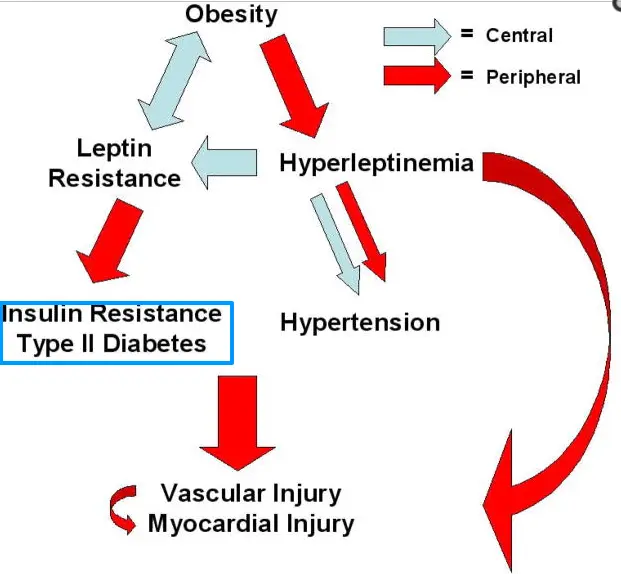
Do you find it impossible to lose weight despite doing “everything right”?
Leptin, more specifically leptin resistance, may be playing a major role.
What is leptin?
Leptin is a hormone that is pumped out by your fat cells (yes, they do more than just give you cellulite!).
The idea is that as you gain fat cells, the fat cells pump out this hormone that is then supposed to tell your brain that you aren’t hungry anymore and to increase your metabolism to burn the extra fat stores.
The problem?
We live in a time of “plenty” and most people have way too many fat cells and as a result, they have too much leptin.
This sequence reduces the influence that leptin has on your brain. Your brain thinks you’re in a state of starvation and severely lowers your basal metabolic rate (16), and whole body metabolism, and increases your appetite.
This process is known as leptin resistance and may be one of the most undiagnosed and underappreciated causes of obesity and weight loss resistance in our society.

Leptin resistance also seems to have some genetic (17) component to it as well. This may explain why some families tend to always struggle with obesity.
How does Leptin Resistance Impact the thyroid?
As leptin levels (and leptin resistance) increase, your body starts to turn T4 into reverse T3 in an attempt to slow down metabolism (because it thinks you’re starving).
Recall from above that asrReverse T3 increases your body starts to directly block thyroid hormone and your metabolism and fat-burning ability will decrease accordingly.
How do you diagnose Leptin Resistance?
If you think that you may be suffering from leptin resistance I recommend asking for the following tests:
- Serum leptin levels: This should be < 10. Anything higher than 10 is a problem indicating that you have leptin resistance if you are also overweight. If your weight is normal and your leptin level is high then that is a normal response.
- Check serum uric acid levels: Anything > 5 is a problem and indicates your body has a problem metabolizing fructose.

How do you treat Leptin Resistance?
Leptin resistance is treated much the same way that Insulin resistance is treated.
Which would include: high-intensity interval training, intermittent fasting, targeted supplements, T3 thyroid hormone replacement, a diet focused on macronutrients, and certain medications such as Saxenda, Victoza, and naltrexone or Contrave.
- Quick Tip: Lifestyle changes may not be enough if your thyroid is under-treated, you have systemic inflammation or you still have insulin resistance. If you fall into this category you may benefit from medications that can sensitize your body to leptin. These include exenatide and pramlintide (they are both diabetic medications but help significantly with weight loss and leptin resistance).
Step #9. Avoid Endocrine Disruptors and Xenoestrogens
Did you know that detox is now mainstream?
Well, at least it should be…
Just recently the Endocrine Society (this is the society that sets the guidelines for how endocrinologists practice) came out with a paper “Executive Summary to EDC-2: The Endocrine Society’s Second Scientific Statement on Endocrine Disrupting Chemicals” which outlined how chemicals we come into contact with on a DAILY basis block your thyroid function at the cellular level.
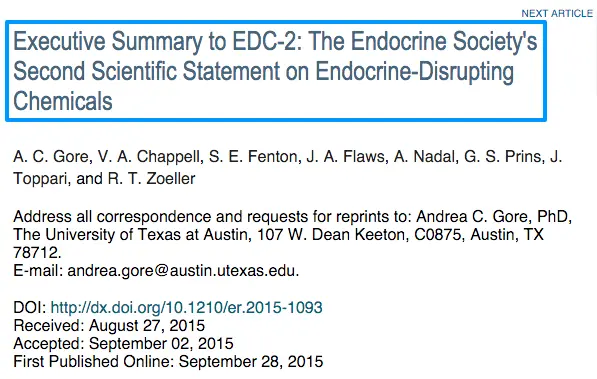
What’s worse? These chemicals lower the ACTIVE thyroid hormone (18) in your blood but don’t affect the TSH!
This means that if your doctor is only testing your TSH they are behind the times…
It also means that if your Endocrinologist or Doctor isn’t teaching you how to avoid these chemicals they are doing you a disservice.
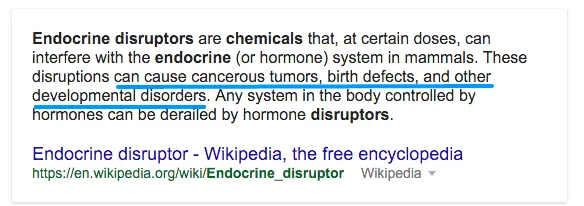
How do you avoid Endocrine Disrupting Chemicals?
So let’s talk about doing that right now…
Here are several tips you can start doing today to ACTIVELY avoid these chemicals that are likely interfering with your thyroid function:
- Stop touching receipts – Receipts have Bisphenol-A (19) (a known thyroid blocker) that is absorbed through the skin whenever you touch one. From here on out ask the cashier to put the receipt in the bag.
- Drink out of glass containers/cups – Avoid plastic containers, water bottles, and canned foods. These contain BPA and/or aluminum.
- Drink only filtered water – Get a reverse osmosis filter for your home if possible. But remember that ANY filter is better than no filter, so just get something.
- Avoid plastic whenever possible – This means plastic toys, food stored in plastic, food wrapped in plastic, etc. And never reheat (20) or microwave food stored in plastic (this causes more chemicals to leach out).
- Avoid bringing plastic toys into your house (opt for wood instead) – Soft rubber manufactured before 2009 is made with Phthalates (another known thyroid blocker). This would be things like rubber duckies, not hard legos made of plastic.
- Eat organic and grass-fed whenever possible and avoid dairy (unless it’s organic/fermented) – Or better yet just ditch the dairy because it’s probably causing inflammation in your body. But at least make sure to buy organic whenever you can.
- Avoid fragrances – If you see the word “fragrance” or “parfum” on the label, run the other way. This is code word for Phthalates.
- Check your cosmetics – Use the resource Skin Deep by the Environmental Working Group to grade your cosmetics based on how many hidden chemicals they have.
You can also find additional quick and easy tips to help you augment existing detoxification pathways that exist in your body to help support thyroid function here.
- Quick Tip: Use all of the above strategies and make sure to sweat profusely at least once a week to help Detox the chemicals that you’ve already been exposed to.
Weight Loss Is Possible Even With Hashimoto’s
My entire goal in writing this article is to give you a renewed sense of hope.
I know it can be hard to lose weight, I know it can feel frustrating, and I know it’s a long journey.
But the key is to just get started and to stay consistent.
This article should provide you with all of the information you need to do just that.
And, if you feel like you want to take a deeper dive into any of the topics I’ve mentioned here, I have videos and articles that go even deeper if that’s your thing.
I want to leave you with one parting thought:
No one cares more about your own health than you.
You can’t count on your doctor to do everything for you which means you will have to do a lot of the leg work on your own.
Accepting this reality is also an important step to take and one that some patients struggle with.
Now it’s your turn:
Are you someone with Hashimoto’s who has struggled to lose weight?
Is this the first time you’ve heard about some of the therapies or treatments listed here?
Have you previously tried any of the treatments listed in this article? Did they work for you?
What have you found to be the most helpful “trick” to weight loss with Hashimoto’s and Hypothyroidism?
Leave your questions or comments below!
Scientific References
#1. http://www.ncbi.nlm.nih.gov/pubmed/21104580
#2. http://www.ncbi.nlm.nih.gov/pubmed/7033265
#3. https://www.ncbi.nlm.nih.gov/pubmed/27345309
#4. http://www.ncbi.nlm.nih.gov/pubmed/19208852
#5. http://dmm.biologists.org/content/4/6/733
#6. http://www.ncbi.nlm.nih.gov/pmc/articles/PMC3963190/
#7. http://www.ncbi.nlm.nih.gov/pubmed/8985315
#8. http://www.medscape.com/viewarticle/853427?nlid=90103_2863&src=wnl_edit_dail&uac=25430DK&impID=872077&faf=1
#9. https://www.ncbi.nlm.nih.gov/pmc/articles/PMC2991639/
#10. https://www.ncbi.nlm.nih.gov/pubmed/12959622
#11. http://www.ncbi.nlm.nih.gov/pubmed/25974299
#12. http://www.ncbi.nlm.nih.gov/pubmed/26100928
#13. http://www.ncbi.nlm.nih.gov/pubmed/20955691
#14. https://www.ncbi.nlm.nih.gov/pubmed/19087366
#15. http://www.ncbi.nlm.nih.gov/pubmed/19753538
#16. https://www.ncbi.nlm.nih.gov/pubmed/17212793
#17. http://www.nature.com/ijo/journal/v25/n10/full/0801736a.html
#18. http://www.ncbi.nlm.nih.gov/pubmed/23337242
#19. https://www.ncbi.nlm.nih.gov/pmc/articles/PMC4685668/
#20. https://www.ncbi.nlm.nih.gov/pmc/articles/PMC3924457/
